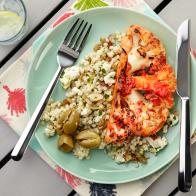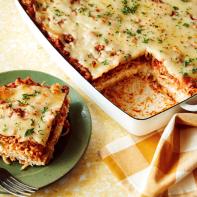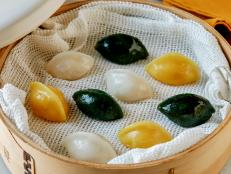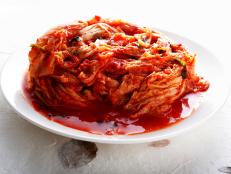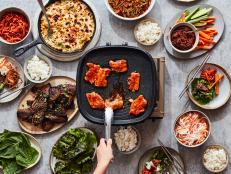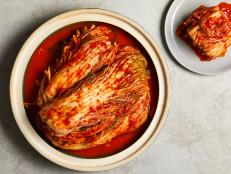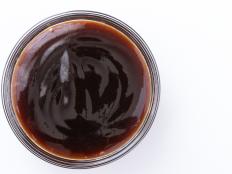What Is Korean American Food? The Answer Is Found at Home.
When Eric Kim took an unexpected detour back to his childhood home in Atlanta, he found himself spending a year developing recipes with his mom and interrogating the definition of the cuisine — at times, a complicated task. The result is his highly anticipated new cookbook, Korean American.


Jenny Huang
Get the recipe: Aunt Anne’s Broccoli-Cheese Rice Casserole
Eric Kim has been thinking and talking about his debut cookbook for years. For a while, it was "Single Malt," which was first a blog where he recorded recipes he cooked for himself during off hours in his teeny studio apartment. This eventually became Table for One, his hit column during his tenure as senior editor at Food52. But ultimately he returned to where he started, his Korean American upbringing in Atlanta, Georgia.
When the pandemic hit, Eric sought shelter back under his parents’ roof. He found himself writing at his childhood desk during the day and cooking with his mother at night, recreating beloved family recipes and inventing new ones. This is now recorded in Korean American a collection of essays and recipes exploring his past and present through food.
I first met Eric in 2016, when we both worked at Food Network. We worked on separate floors but connected immediately, as Koreans often do whenever we find each other out in the world. I popped up to visit him in his cubicle, plastered with British flags and magazine tears featuring Nigella Lawson, his forever idol. He came to help cook at my Korean American food popups in Brooklyn, dog-eared novel in hand. But we most often met up for happy hour, sneaking out of work an hour early to grab a couple seats downstairs in Chelsea Market. We gabbed about work of course, but also burgeoning relationships, fading loves, and always, Eric’s dreams of writing a cookbook.
These happy hours eventually migrated to Village Yokocho, a little Japanese izakaya near St. Marks Place, once we left our respective positions. The nights would unwind over chicken skin skewers and hot sake while we talked, again, about Eric’s cookbook — this time a reality signed into paperwork. The question laid heavy, as it still does today: "What is Korean American food?"
Korean American charts Eric’s journey leaving home and subsequent homecoming — a full circle exploration of his childhood growing up in an immigrant family living in Atlanta. There are pit stops through North Carolina for spicy fish stew with his cousins, visits to the classic Korean bakery for some milk bread, and homages to restaurant seolleongtang in New York where he attended college and lives today. Eric’s essays fill out the framework of his recipes, connecting lines across the Korean immigrant wave in the 1980s, soaring through his love for food TV cultivated as a latchkey kid, and culminating in an all-encompassing celebration of life, both lived and lost.
Eric and I met at Village Yokocho in early March of 2022 to talk about his book:
You’ve been wanting to write a book or cookbook for a while, and you’ve had a couple previous iterations for the idea — moments in time that you’re exploring based on your past, or things that bring you joy. Do you feel like Korean American has elements of these, or an entirely new concept?
It’s more an evolved iteration. I had been focused on Table for One [as a pitch] for so long that no agent wanted that book, so I turned it into a column and wrote it for two years, which got it out of my system. When I asked my manager [at Food52] if I could write a Korean column, they urged me to continue Table for One instead and explore Korean cooking there. I'm really grateful the column didn't materialize, because instead it became this book. I think what’s important about the book is that it literally narrates my education about Korean cooking, which I learned in one year from my mom. I was cooking dishes from my childhood for the first time, like the dishes in the “Kimchi is a Verb” chapter. Last time we were here, we were talking about the concept of how to represent or talk about Korean food.

I was saying at the time that each Korean person has their own experience, so don’t worry too much about whether or not you’re representing Korean food, and just write about it from your own perspective.
It’s hard to write a book about your own cuisine because in order to write it well, you have to be unbiased and look at it as a reporter. I had to get introspective about the semantics and politics of the Korean pantry, and the Korean kitchen, and watch my mom cook with an open mind and try to absorb it without my white media gaze, which is how we’re all trained that food media was supposed to be. I had to learn a lot of language before I could start, like the difference between mirin and mirim [a conversation we had when Eric began writing his cookbook — I told him mirin is a Japanese cooking wine, while mirim is the Korean-specific word for a similar product].
What was it like creating and cooking all these recipes with your mom, after growing up having your mom cook for you? How did that change your dynamic, if at all?
I really enjoyed becoming a mom and experiencing what that was like. Every night I had to somehow feed my family, and that produced some really exciting cooking, like the sheet pan bibimbap — it was a way to feed four people quickly. The point of dinner is no longer just for yourself, and learning to feed someone else really opens up your creativity.
So what makes Korean American food, American food?
Because Korean is an adjective for American. This isn’t a Korean cookbook, this is an American cookbook. And Korean Americans are American. There’s no definition yet, and the more we try to define it the more we’re going to limit a swath of people.
For example, my broccoli cheese rice casserole, which is part of my Thanksgiving spread, doesn’t have a Korean twist, it’s just our family recipe. It’s Korean American because rice is the most important thing on our table, something that always has to be on the table. At Thanksgiving, there’s no bowl of rice, but there’s that broccoli cheese rice casserole.
We’ve talked in the past about what it means to be Korean versus American versus Korean American, and the creation of this third culture type of identity and food. How important was it to preserve the way your mom did things versus creating a new thing?
I view it as both. I care about preservation, but I don’t think that innovating is the same as erasing the past. We need to see the evolution of food as part of the story. The way to preserve is to innovate; in urban studies they talk about how old cities die because people are trying to preserve it, but trying to extend its life into the future means you need to add acid and vinegar and salt and ferment it, like kimchi.
Like the way people think that certain Korean recipes have to be authentically Korean, even though the history of that specific dish is often not even that old or as authentic as it’s made out to be, like LA kalbi or even bulgogi.
Yeah, even as of the 1970s, Korea was still a new country [in its current iteration].
Did writing this book help you discover yourself as a Korean American?
It didn’t really happen until I quarantined with my family, which brought out a lot of memories. I felt like I was in a time warp — writing this book as a 28-year-old in my 17 year old bedroom, which is a very bizarre feeling that most people don’t experience. Moving back home was a way to complete myself, combining my past self and my present self.
So this is really a quarantine cookbook, isn’t it?
The book became a home-cooking book — when I first concepted I had intended to travel and interview other Korean American families. But instead I went into lockdown and had to make the book smaller, but it became an opportunity to excavate my relationship with my family, resurface hardships, and even experience deaths.
It might be a common trope that the child of immigrants doesn’t learn how to cook the cuisine of their parents’ country — because the parents are alive to cook it. I was the Korean kid who had only focussed on American food because I thought that my parents were going to live forever, but as an adult I had to learn it, because otherwise it would be lost. I ended up writing a book to celebrate the life of my family.
This interview has been edited and condensed for clarity.
Related Links:


